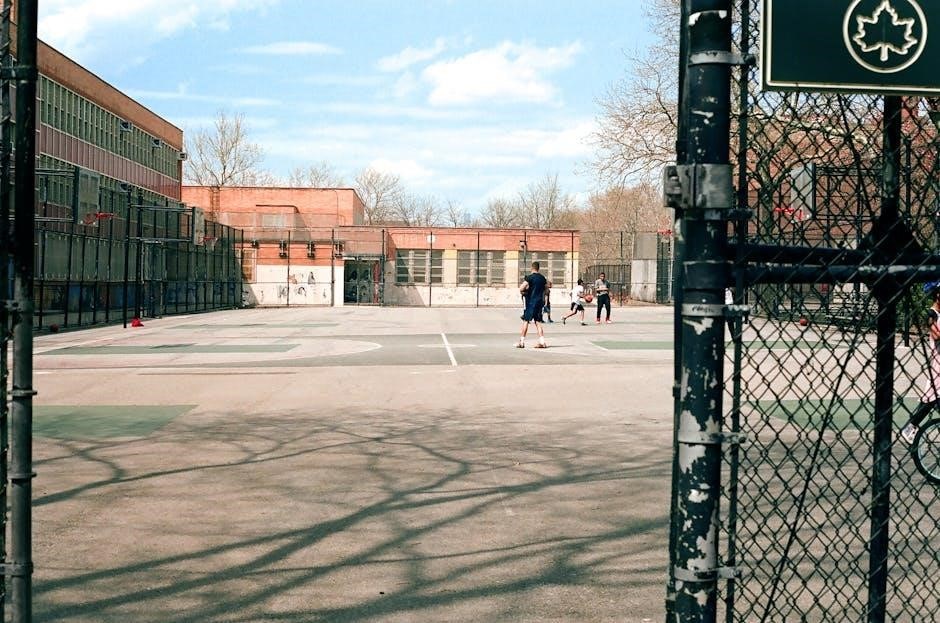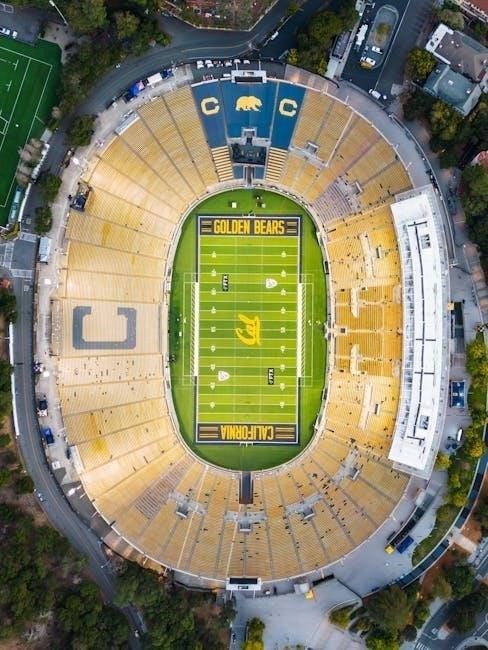Overview of High School Basketball Court Dimensions
High school basketball courts typically measure 84 feet in length and 50 feet in width. This is smaller than college or professional courts.
Standard Dimensions in Feet and Meters
A high school basketball court’s standard dimensions are 84 feet long and 50 feet wide. In metric units, this translates to approximately 25.6 meters in length and 15.24 meters in width. These dimensions define the playing area for high school games. While the length differs from college and NBA courts, the width remains consistent. Junior high courts may have even smaller dimensions, typically measuring 74 feet long and 42 feet wide. It’s essential to recognize these standard measurements for accurate gameplay and practice. The consistent width allows for similar spacing and player movement across different levels of play. Understanding the dimensions in both feet and meters is beneficial for international comparisons and facility planning. The reduced length in high school provides a more manageable court size for younger players.
Key Dimensions and Markings
Key dimensions include the free-throw line, 15 feet from the backboard, and the key width. Markings define boundaries and playing zones on the court.
Width of the Key
The width of the key, also known as the free-throw lane, is a crucial dimension on a high school basketball court. It defines the area where players can position themselves during free throws and restricts offensive players from remaining for more than three seconds. In high school basketball, the key is 12 feet wide, narrower than the 16-foot width used in NBA and college courts. This narrower key impacts gameplay, affecting rebounding positioning and strategies for defending the paint. Players must adapt their spacing and movement within this confined zone. The key’s dimensions also influence defensive strategies, requiring adjustments in zone formations and individual player positioning to effectively protect the basket. Understanding the specific width of the key in high school basketball is essential for both offensive and defensive game planning and execution, allowing players to maximize their performance within the defined space and adhere to the rules governing movement and positioning within the key area during live play and free-throw situations.
Free-Throw Line Distance
The free-throw line distance is a critical measurement on any basketball court, including those used in high school games. It’s the line from which players shoot uncontested free throws after a foul. In high school basketball, the free-throw line is positioned 15 feet away from the backboard. This distance remains consistent across all levels of play, from junior high to professional leagues. The consistent distance allows players to develop consistent shooting mechanics that translate across different court sizes. This standardization is important for player development, ensuring that practice translates effectively to game situations. The free-throw line is also 18 feet 10 inches from the baseline. Mastering free throws at this distance is vital for success at the high school level. Players dedicate countless hours to practicing their free-throw technique to improve their accuracy. The free-throw line is a key location for scoring and can significantly impact the outcome of close games, emphasizing the importance of consistent practice and skill development at this specific distance. The ability to convert free throws consistently is a valuable asset for any high school basketball player.

Three-Point Line Distance
The three-point line in high school basketball is 19 feet 9 inches from the center of the basket. This distance differs from other levels of play.
High School vs. Other Levels
The three-point line distance in high school basketball presents a notable contrast when compared to other competitive levels. Specifically, the high school three-point line is positioned at 19 feet and 9 inches from the center of the basket. This measurement is distinct from both college and professional basketball, where the three-point line is set at a farther distance. In college, the distance varies between 21.65 feet and 22.15 feet, while the NBA boasts an even greater distance of 23 feet and 9 inches at the top of the arc. This difference profoundly influences shooting strategies and overall gameplay. High school players must develop accuracy within their specific range, which is crucial for their success at that level. The shorter distance often results in a higher volume of three-point attempts in high school games. As players transition to higher levels of basketball, they must adapt to the increased distance of the three-point line, which demands greater shooting range and adjustments to their shot mechanics. This variation in three-point line distance highlights a key distinction in the game’s dynamics across different levels of competition, shaping player development and strategic approaches.

Comparison to Other Court Sizes
High school courts are smaller than NBA and college courts. NBA courts are 94′ x 50′, while college courts are similar. Junior high courts are even smaller.
NBA and College Courts
NBA basketball courts boast the largest dimensions among the common levels of play, measuring a substantial 94 feet in length and 50 feet in width. These expansive courts provide ample space for professional athletes to showcase their skills, execute intricate plays, and engage in fast-paced, high-scoring games. College basketball courts share the same dimensions as their NBA counterparts, maintaining the 94-foot length and 50-foot width. This consistency allows players transitioning from high school to college to adapt more seamlessly to the court size. The increased size compared to high school courts demands enhanced stamina, strategic positioning, and refined ball-handling skills. Both NBA and college courts also feature a wider key and a longer three-point line distance than high school courts, further differentiating the gameplay and requiring adjustments for players at these higher levels; These dimensional differences impact spacing, defensive strategies, and offensive opportunities. Understanding these variations is crucial for players aspiring to compete at the collegiate or professional level, as they must develop the physical and technical abilities to excel on these larger playing surfaces. The standard sizes of the court also help viewers get a sense of scale;
Junior High/Middle School Courts
Junior high or middle school basketball courts are intentionally designed with smaller dimensions than high school courts, catering to the developing physical capabilities of younger players. These courts typically measure 74 feet in length and 42 feet in width, providing a more manageable playing area for athletes who are still growing and refining their skills. The reduced size allows for quicker transitions, more frequent scoring opportunities, and increased player involvement. This encourages greater participation and fosters a more engaging and enjoyable experience for young players. The smaller court dimensions also necessitate adjustments in gameplay strategies and individual skill development. Players learn to navigate tighter spaces, make quicker decisions, and develop more precise passing and shooting techniques. Coaches can emphasize fundamental skills and tactical awareness without overwhelming players with the demands of a full-sized court. Furthermore, the reduced court size can help prevent injuries by minimizing the distances players need to cover and reducing the risk of collisions. The adjusted dimensions of junior high and middle school courts play a vital role in fostering a positive and developmental basketball experience for young athletes, setting the stage for their future growth and success in the sport. The players can better master the basics.

Impact of Dimensions on Gameplay
The dimensions directly influence gameplay, dictating spacing, pace, and strategy. Smaller courts lead to faster, more physical games and quicker scoring.
Muscle Memory and Spatial Recognition
Consistent practice on a standard-sized high school court is paramount for developing muscle memory and spatial recognition. Players become attuned to the specific distances and boundaries, allowing them to make instinctive decisions during games. Repeatedly executing drills and plays on the same dimensions allows for improved shooting accuracy, passing precision, and defensive positioning. Muscle memory enables players to react quickly and efficiently without conscious thought, while spatial recognition helps them understand their location on the court relative to teammates, opponents, and key landmarks like the three-point line and free-throw line. This familiarity translates to enhanced confidence, better decision-making, and ultimately, improved performance on the court. Players learn to anticipate movements, make accurate passes, and take shots with greater consistency due to their ingrained understanding of the court’s specific layout.

Importance of Standard Dimensions for Practice
Practicing on a basketball court with standard high school dimensions is crucial for player development and team success. The consistent court size allows players to develop accurate muscle memory and spatial awareness, essential for making quick, informed decisions during gameplay. When players train on a court that mirrors the dimensions of those used in official high school games, they become intimately familiar with the distances required for shooting, passing, and defensive positioning. This familiarity reduces hesitation and improves reaction time, as players instinctively understand their location and the optimal strategies to employ. Furthermore, practicing on standard dimensions ensures that players are prepared for the specific challenges and opportunities presented by high school basketball, fostering confidence and enhancing their overall performance. It also allows coaches to implement effective game plans and strategies that are tailored to the specific dimensions of the court, maximizing the team’s potential.